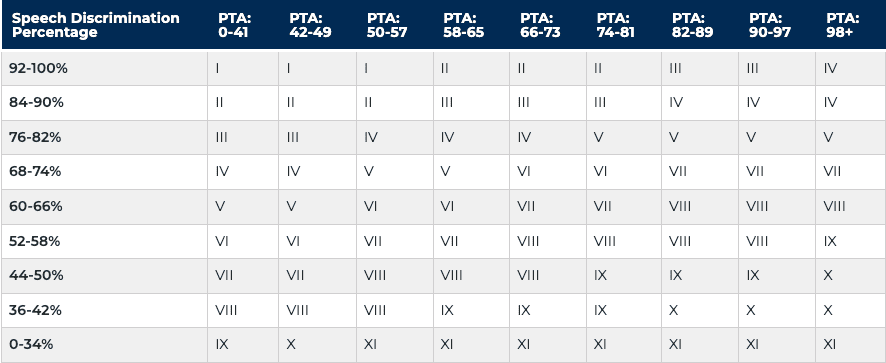Looking for Expert-Level VA Claim Answers?📱Call Us Now! 737-295-2226
Hearing loss is one of the most common service-related health issues faced by veterans, yet many aren’t aware that they could be eligible for a hearing loss VA rating and compensation.
In this post, we’ll break down how to get a hearing loss VA rating and help you understand the key factors to make your case stronger and improve your chances of getting approved.
Let’s get started.
Table of Contents
Summary of Key Points
- The VA rates hearing impairment disabilities according to veterans’ hearing test results.
- The VA uses two specific hearing tests, the Puretone Threshold Average (PTA) and the Maryland CNC test’s Percent of Speech Discrimination, to rate hearing-impaired disabilities.
- Hearing loss can be considered a secondary service-connected disorder when it’s caused by a primary service-connected condition, such as Ménière’s disease.

Hearing Loss in Veterans
Whether it’s from the constant noise of aircraft, gunfire, heavy machinery, or combat exposure, many veterans suffer from hearing-related problems like tinnitus and hearing loss as a direct result of their military service.
Studies show that veterans are more likely than civilians to experience severe hearing impairment. The sounds of training exercises, combat, or even day-to-day duties on the flight line can have lasting effects that prevent veterans from leading a normal life.
If you’ve experienced hearing loss due to your military service, you could be entitled to VA disability benefits. However, hearing loss claims are often one of the most difficult types to get approved. Veterans frequently face challenges when trying to prove that their hearing loss is connected to their time in service, and claims are commonly denied or rated lower than expected.
How Does the VA Define Hearing Loss?
Hearing loss, also known as deafness or hearing impairment, refers to the partial or complete inability to hear sounds. The severity of hearing loss can vary from slight to profound:
- Slight hearing loss: You may have difficulty understanding speech, especially in noisy environments.
- Moderate hearing loss: You might require hearing aids to assist with communication.
- Severe or profound hearing loss: You could struggle to understand most sounds, making communication extremely difficult.
If you have slight hearing loss, your primary problem may be understanding speech with a lot of background noise. Moderate hearing loss may result in the need for hearing aids.
However, if your hearing loss is severe or profound, communication is likely challenging because of difficulty discerning sound.

Hearing Loss VA Ratings (0-100%)
Hearing Loss is rated under CFR Title 38, Part 4, Schedule for Rating Disabilities, Diagnostic Code (DC) 6100, Hearing Loss.
A VA Rating for Hearing Loss can be 0%, 10%, 20%, 30%, 40%, 50%, 60%, 70%, 80%, 90%, or 100%.
-
Pro Tip: The best way to increase your hearing loss rating is to have objective medical evidence—for example, Audiogram results, that show your symptoms have worsened over time.
What is the average VA rating for hearing loss?
The average hearing loss VA rating is 10%; many veterans have a 0% rating.
What is the highest VA rating for hearing loss?
The highest scheduler rating for Hearing Loss is 100%, which means you have total deafness in both ears.
Types of Service Connection for Hearing Loss
There are 3 main ways to be granted a VA rating for Hearing Loss: Direct service connection, secondary service connection, and service connection due to aggravation.
-
Pro Tip: If you’ve been out of the military for more than 12 months, it’s challenging to get service connected and rated above 0% for your hearing loss. However, obtaining a high-quality Nexus Letter can improve your chances of being granted service connection.
Direct Service Connection
An in-service event, injury, or disease related to your military service caused you to develop Hearing Loss.
Secondary Service Connection
When another primary service-connected disability causes your hearing loss. This is uncommon as hearing loss is typically directly service-connected. A nexus letter is needed to support a claim for secondary service connection.
Conditions Secondary to Hearing Loss
Below is a list of some of the conditions that may be secondary to service-connected hearing loss.
- Adjustment Disorder secondary to Hearing Loss
- Anxiety secondary to Hearing Loss
- Depression secondary to Hearing Loss
- Meniere’s Syndrome secondary to Hearing Loss
- Vertigo secondary to Hearing Loss
Aggravation of a Pre-Service Disability
If your military service “aggravated” your pre-existing hearing loss condition beyond its natural progression, you can get hearing loss service-connected and rated based on aggravation.
Levels of Hearing Loss
The table below illustrates the general levels of hearing loss veterans experience (i.e., mild, moderate, severe, and profound).
Hearing Loss VA Rating Chart
| VA Rating | Level of Hearing Loss |
| 0% to 10% | Mild hearing loss may involve difficulty hearing in noisy environments. |
| 20% to 30% | Moderate hearing loss involving a struggle to understand some conversations without visual cues to moderately severe hearing loss involving difficulty hearing in most listening situations. |
| 40% to 50% | Severe hearing loss involving the inability to understand speech without amplification (e.g., hearing aids), to extremely severe hearing loss involving extremely difficult communication even with hearing aids. |
| 60% to 100% | Involves near-total deafness in both ears |
Note: Hearing aids do not necessarily impact your VA rating; the VA rates the level of your hearing loss without hearing aids.
Tests for Hearing Loss
The VA uses two tests to determine your disability rating for diagnostic code (DC) 6100, (i.e., hearing loss), which is rated under 38 CFR § 4.87 Schedule of ratings—ear.
The tests include the Pure Tone Audiometric Test and the Maryland CNC test’s Percent of Speech Discrimination.
Pure Tone Audiometric Test
Pure Tone Audiometric Test uses earphones that emit sounds into one ear at a time. The test identifies the quietest sound you hear at different pitches or frequencies.
Maryland CNC Test
The Maryland CNC Test measures hearing loss via a word test that measures speech recognition. Test results determine the severity of your hearing loss and whether your condition qualifies for a VA disability rating.
The VA hearing loss rating table is based on several factors, including:
- The degree of hearing impairment in each ear
- The results of audiometric testing results
- A complex formula that calculates the rating based on audiometric testing (the more significant the hearing loss result, the higher the VA rating)
Real-Life Impact vs. Hearing Impairment Assessment Results
Although the real-life impact of hearing loss is often more significant than audiogram test results may suggest, the VA rates hearing loss strictly according to the test results.
How Hearing Test Results are Calculated
The VA considers your Puretone Threshold Test result average in each ear (see Table VI below) to measure the severity of your hearing loss.
Table VI below is used to determine the extent of your hearing loss by employing the following method:
- Using your hearing test results from the Maryland CNC test’s Percent of Speech Discrimination and the Pure-tone Threshold Average (PTA) test, assign a Roman number—from I to XI—according to the chart below.
- Note that the far-left column (starting with 92-100 and ending with 0-34) of Table VI represents your test results for the Maryland CNC test/Speech Discrimination Percentage, and the bar across the top—beginning with “0-41 and ending with 98+—represents the Percentage and Pure-tone Threshold Average (PTA) test result.
- The Roman numerals corresponding to your hearing test results can be found where the PTA and Speech Discrimination Roman numerals intersect. For example, if your “Pure-Tone Threshold” average is 56, and your “Percentage of Discrimination” speech test result is 77%, then the Roman numeral rating for your first ear would be IV.
After rating your first ear, repeat the process to identify a Roman numeral for your second ear.


Once a Roman numeral is assigned to each ear, use Table VII below to find your VA rating for hearing loss disability using these steps:
- In Table VI (below), the Percentage of Speech Discrimination results appear in the horizontal rows, and the Puretone Threshold Average (PTA) results are in the vertical columns.
- Locate the Roman numeral on the chart that denotes your hearing results in your “better” ear (i.e., the one with the smaller Roman numeral).
- Find the Roman numeral on the chart that denotes your hearing results in your “poorer” ear (the one with the larger Roman numeral).
- Your final hearing loss VA rating can be located in the intersecting box of these two Roman numerals. For example, if your better ear has a Roman numeral of III, and your poorer ear has a Roman numeral of VI, your VA hearing loss rating is 10%.

Table VII illustrates that getting a VA hearing loss rating above 10% is challenging.
VA Disability Rating for Bilateral Hearing Loss
For veterans with bilateral hearing loss (i.e., hearing loss in both ears), a final rating is determined by the testing results of the severity of each ear separately. This may result in a higher overall rating than unilateral hearing loss.
DC 6100, the same diagnostic code as unilateral hearing loss, is used. The VA uses the Numeric Designation for Hearing Impairment Based on the Pure Threshold Average and Speech Discrimination chart to rate bilateral hearing loss.
What is the Difference Between Hearing Loss and Tinnitus?
While both are common hearing-related conditions, hearing loss and tinnitus are distinct:
- Hearing loss: This is an objective condition where an audiologist measures the loss of hearing at various decibels and frequencies. It can range from mild to profound, and it impacts your ability to hear sounds.
- Tinnitus: Often referred to as “ringing in the ears,” tinnitus is subjective, meaning it’s experienced differently by each individual. Tinnitus is the sensation of hearing sounds (like ringing, buzzing, or hissing) that are not actually present. It is the most commonly claimed VA disability, but it is typically rated at 10% or nothing.
While tinnitus is easier to claim and has a fixed VA rating of 10% or none, hearing loss can vary significantly in terms of severity and VA rating, depending on the results of audiometric testing.
Medical Conditions that May Cause Hearing Loss
Several medical conditions can contribute to hearing loss. Therefore, hearing loss could be considered a secondary condition linked with service-connected:
Otosclerosis
A rare disorder of the middle ear that makes it difficult for the tiny bones to move freely, impairing normal hearing.
Meniere’s disease
Affects the inner ear, disturbs hearing and balance, and causes symptoms of vertigo and tinnitus.
Diabetes
This may cause hearing to worsen over time, making it challenging to notice symptoms immediately.
Tumors
Acoustic neuroma is a non-cancerous tumor that grows on the nerve involved in hearing and balance. Hearing impairment can occur even after surgical removal of the tumor.
Filing VA Disability Claim for Hearing Loss
VA disability compensation may be available if you sustained hearing loss while serving in the military. You must first file a VA hearing loss disability claim.
Fill out VA Form 21-526EZ and submit it along with any supporting documentation (e.g., service records, medical reports, and exposure documentation) to your local VA Regional Office.
You can also submit your disability claim form and upload your supporting documents via the VA.gov website. A Veteran Service Officer (VSO) can help you print, download, and complete forms if you need help.
Conclusion
In summary, the VA uses specific hearing tests to rate hearing-impaired disabilities. While getting a VA rating above 10% for hearing impairment is challenging, it’s not impossible. There are resources that strengthen your claim, such as a nexus letter, which is often the key to linking hearing loss with existing service-connected conditions.

(FAQs) Frequently Asked Questions
What types of hearing loss exist?
There are three primary types of hearing loss:
- Conductive hearing loss: This occurs when sound waves are not efficiently transmitted through the outer and middle ear. Causes include ear infections, earwax buildup, and issues with the eardrum or ossicles (small bones in the ear).
- Sensorineural hearing loss: This type of hearing loss results from damage to the inner ear or the auditory nerve. It is often caused by long-term exposure to loud noises and cannot be reversed.
- Mixed hearing loss: This is a combination of conductive and sensorineural hearing loss. Some hearing loss may be treatable with surgery, though outcomes can vary.
Do I need to have a hearing test to file a VA disability claim?
Yes, the VA will require two types of hearing tests from qualified audiologists to assess the severity of your hearing loss.
What is the VA rating for hearing loss?
VA ratings for hearing loss are 0%, 10%, 20%, 30%, 40%, 50%, and 60 to 100%, depending on your hearing test results and whether you have hearing loss in one or both ears.
If my hearing loss rating is denied, can I appeal the VA’s decision?
An appeal is possible if you disagree with the decision made in your initial rating.
What benefits and compensation am I entitled to if my hearing loss disability claim is approved?
If you receive a rating of 10% or higher, you will receive monthly tax-free compensation payments via direct deposit or check. The first payment is issued within 15 days of receiving your decision notice.
What is the typical VA rating for hearing loss or other ear conditions?
- Tinnitus: This is the most commonly claimed ear condition and is rated at 10% or nothing.
- Meniere’s Disease: This condition is rated based on the severity of vertigo and balance issues. Ratings range from 30% to 100%, depending on the frequency and severity of symptoms.
- Inner Ear Disorders: Depending on symptoms like dizziness, vertigo, and nausea, the VA may rate these disorders at either 10% or 30%.
- Loss of Ears: If you lose one ear, the VA assigns a 30% rating. Loss of both ears can result in a 50% rating, with a bilateral factor.
- Perforated Eardrum: This condition is rated at 0%, but it can be considered for additional compensation if it results in other issues like hearing loss or recurrent infections.
- Total Hearing Loss: Veterans who are completely deaf in both ears may qualify for Special Monthly Compensation (SMC), a higher level of compensation for severe disabilities.
RELATED Posts & Guides
Do’s and Don’ts of Filing a Tinnitus Claim
How a 10% Tinnitus VA Disability Rating Could Be Worth 100% Combined!

Want Expert-Level Support for Your VA Disability Claim? WE GOT YOUR SIX!
How does VA Claims Insider help veterans?
We make the confusing and frustrating VA claim process EASY through our 8-step proprietary system and one-on-one coaching; we’re the VA Claim EXPERTS you can trust, and YOU are never alone in this fight against the VA!
You’ll also receive VA disability expert Brian Reese’s SEM Method Blueprint—a proven formula that has helped over 25,000 veterans win their VA disability claims faster:
Strategy + Education + Medical Evidence = VA Rating and Compensation You Deserve FASTER!
Start today and unlock an exceptional level of service you deserve for serving our country:
- You’ll hear from a VA Claim Expert over email within 15 minutes of signing up today.
- You’ll hear from your Veteran Coach team within 24 hours of all inquiries during normal business days/hours.
- Our terms are clear and simple: If we don’t win, you don’t pay. You have nothing to lose and everything to gain.
Click the red button below to start the process of winning your VA claim right now!
About VA Claims Insider
- VA Claims Insider is the #1 most trusted name in VA disability claims.
- Work directly with a VA claims coach who can educate you to VA claim victory.
- 25,000+ disabled veterans served in our membership programs since 2016.
- 30% average rating increase for veterans who complete our #1 rated Elite program.
- 4.7/5.0 average rating out of 5,500+ total reviews; over 4,500 5-star reviews.

Sherry Christiansen
Sherry Christiansen is a professional Medical Writer with a clinical mental health background. Over the last decade, she has written health and wellness articles for organizations like Medical News Today, Verywell Health, and Healthline. In 2013, she also helped launch an educational website for the first Alzheimer’s prevention clinic in the country at Weill Cornell Medical Center – NewYork-Presbyterian. As a spouse of a career military service member, Sherry is deeply passionate about supporting veterans. It is an honor for her to assist veterans in receiving the benefits they deserve after becoming ill or injured while serving our country.




